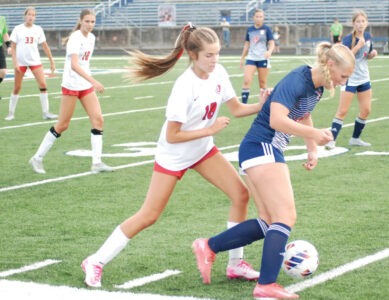Second coaching stints don’t always pan out

West Virginia head coach Rich Rodriguez takes questions at the podium during a press conference. (Photo by Greg Hunter/BlueGoldNews.com)
MORGANTOWN — History tells us that bringing a former coach back for a second run after a long departure, as West Virginia is doing with Rich Rodriguez, is a risky proposition.
Rodriguez built the team from a 3-8 team in 2001 when he replaced Hall of Fame coach Don Nehlen to a team on the brink of a national championship game before jumping to Michigan that set him off on a journey where he was head coach at Arizona, an assistant at Ole Miss and Louisiana-Monroe, head coach at Jacksonville State in Alabama and then rehired after 17 years at WVU.
It wasn’t the Mountaineers first recycling of a head football coach, going all the way back to the turn of the century — the 20th century. Louis Yeager coached the Mountaineers in 1899 to a 2-3 record, then again in 2002 when the Mountaineers went 7-4. Yeager, a Mountaineer fullback and captain of the 1898 team, became a lawyer in Morgantown in 1901 and died of heart disease in 1906.
Ira Rodgers, one of the greatest of WVU athletes, coached WVU from 1925 to 1930, going 8-1 in 1925 and 8-2 in 1928. He came back and filled in when Bill Kern left for the U.S. Navy Pre-Sight program during World War II, coaching the team from 1943 to 1945.
Kern had coached the Mountaineers from 1940 to 1942 before reclaiming the job after the war in 1946 and 1947.
A great number of coaches — and players — saw their careers interrupted for World War II, but it is something that while not common isn’t unheard of, either.
Over the history of the game, a great number of college coaches have left a school for what they felt were better jobs or to try their hand at the pro game, only to return to their former schools. As a rule, they have not recaptured the same magic they had the first time around.
Rodriguez has felt he could pull it off even at age 60 and with a 17-year gap in his resume.
“I’m older, smarter, hopefully wiser and probably more appreciative than I was before,” he said when named to the job. “But, at the same time it’s a job, it’s work, it’s a labor of love.
“I’m not the same guy,” he continued on the day he was introduced. “If I expect my players and coaches to get better every year and every day and every week, I have to do the same thing. I’m not the same coach I was 17 or 18 years ago. I better be better.”
He says his long and varied experience will give him something to draw upon.
“I have 28 years as a head coach experience. It wasn’t one year repeated 28 times. I kept getting better. I’m going to be a better coach in a month than I am today. I want the same thing from my staff and my players,” he said.
Here is a brief recap of some other prominent coaches who have left a major college coaching job and returned to the same school and a look at how they did.
Other prominent coaches:
Mack Brown, North Carolina, 1988-1997, 69-46-1, .600, Bowls 3-2, No. 6 in best poll. Second term, 2019-2024, 44-33-0, .571, Bowls 1-4, No. 18 top poll.
Brown got off to an awful start at North Carolina, going 1-10 in each of his first two seasons, but wound up going 10-2 and 10-1 in last two years before leaving for Texas, where he stayed for 16 years winning 206 games. His return to North Carolina though could not match that magic as he went 44-33 in 6 seasons.
Johnny Majors, Pitt, 1973-76, 33-13, .718; Bowls 2-1, won national championship in 1976. Second term: 1993-96, .274, no bowls or rankings.
Majors had a losing record in five years at Iowa State before taking the Pitt job, where he went 21-13-1 in his first three seasons before catching lightning in a bottle in the form of Tony Dorsett and Matt Cavanaugh to go 12-0 and win the national title by beating Georgia in the Sugar Bowl. He jumped to Tennessee where he coached for 16 years, where he had three Top Ten finishes but never matched the Dorsett year. His return at Pitt proved to be a dismal time, going 12-32.
John Robinson, USC, 1976-1982, 67-14-2, .819, Bowls 4-1, finished No. 2 in nation three times and was a national champion in 1978. Second term: 1993-1997, 37-29-2, .559, 3-0 in bowls, No. 12 in best poll.
John Robinson replaced John McKay at USC and went 11-1 in his first year and 12-1 in his third year while being named national champion with Charles White as his star player. He went to the NFL for a decade before returning to the Trojans for five more years in which he never reached double figures in wins but did win a Cotton Bowl and a Rose Bowl.
His time in the NFL was successful with the Los Angeles Rams as he twice reached the conference championship game but lost both, coached not only Charles White in the NFL but Eric Dickerson and was the Rams’ top winner as a coach with wins until Sean McVay surpassed him in 2024.
Bill Walsh, Stanford, 1977-78, 17-7, .708, 2-0 in bowls, top ranking No. 17; Second term: 1992-94, 17-17-1, .500, 2-0 in bowls, No. 9 in poll his first year back.
Bill Walsh was an innovative offensive coach whose greatest success came in the NFL and who was inducted into the Hall of Fame after winning three Super Bowls with the San Francisco 49ers with Joe Montana, Steve Young and Jerry Rice leading the way. At Stanford a second time, he never could find that same kind of success.
Bill Snyder, Kansas State, 1989-2005, 136-74, .648, 6-5 in bowls, a high ranking of No. 6. Second term: 2009-2018, 79-49, .617; 3-5 in bowls, high ranking of No. 12.
Bill Snyder literally saved the Kansas State football program not once but twice. The Wildcats were 3-40 in the four years before Snyder was hired in 1989 and his first year was more of the same with a 1-10 record, but starting in his fifth season they won nine or more games in 10 of 11 seasons.
Snyder retired after the 2005 season but they quickly became the not-so-wild cats that they had been, going 17-19 the next three years. Coming out of retirement, Snyder got them back into contention in the Big 12 in his third season and coached them for a full decade before retiring again in 2018.
Bobby Petrino, Louisville, 2003-2006, 41-9, .820, 2-2 in bowls, high ranking of No. 6. Second term: 2014-2018, 36-24,.600; 1-3 in bowls, No. 21 top ranking.
Bobby Petrino was quickly a star at Louisville, going 9-4 and 11-1 in his first two seasons and then going 9-3 and 12-1 in the next two years. One of those losses were when Pat White and Steve Slaton first stunned them with a comeback 46-44 overtime victory that introduced the two to Mountaineer fans.
Petrino signed a 10-year, $25.6 million to coach the Cardinals in 2006 but left six months later to coach the Atlanta Falcons. He set out to build his team around quarterback Michael Vick, who got caught up in a dog-fighting scandal, leading to Petrino’s resignation in 2007 to coach Arkansas.
By 2011, Arkansas was a national contender, ranked No. 5 in the nation, but he was fired after a motorcycle accident that led to the revelation he was involved in an affair. In 2014, Louisville hired him back and he coached Lamar Jackson to the Heisman Trophy, but the success did not last and he was fired after a 2-8 record in 2018.
Greg Schiano, Rutgers, 2001-2011, 68-67, .504, 5-1 in bowls, No. 12 highest final ranking. Second term: 2020-present, 26-34, .433, 1-2 in bowls, never ranked.
Rutgers was 3-8 in 2000 and 0-7 in Big East play when Terry Shea was replaced by Greg Schiano. Schiano had a massive rebuilding job ahead of him, going 3-20 in his first two seasons. Included in that was his first meeting with WVU and its new coach Rich Rodriguez that first season in which Schiano suffered through an 80-7 beating, not scoring until WVU was ahead 73-0 in the fourth quarter.
He slowly built the program until it went 11-2 in 2006 and after a 9-4 record in 2011, he left to coach the Tampa Bay Buccaneers, lasting just one season. After two seasons coaching high school ball, he joined Urban Meyer’s staff at Ohio State as a defensive coordinator before being rehired at Rutgers in 2020, where he began rebuilding again.





